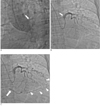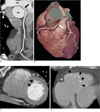Abstract
A 63-year-old man was admitted with complaints of exertional dyspnea and atypical chest pain. Coronary angiography and 64-slice multidetector computed tomography (MDCT) revealed an anomalous origin of the right coronary artery from the pulmonary artery (ARCAPA). He received a coronary artery bypass graft (CABG). The incidence of ARCAPA is extremely rare. We report here on the first case of ARCAPA that was noninvasively diagnosed and postoperatively followed up with 64-slice MDCT.
An anomalous origin of the right coronary artery from the main pulmonary artery (ARCAPA) is a rare congenital cardiac malformation. As compared to the patients with a left coronary artery from the pulmonary artery (ALCAPA), most of the patients with ARCAPA remain asymptomatic. The premorbid diagnosis of ARCAPA has been made with conventional angiography for several decades. However, this imaging technique has limitations due to its invasive nature. The recent development of multidetector computed tomography (MDCT) allows accurate and non invasive depiction of the origin, course and termination of coronary artery anomalies.
We report here on the first case of ARCAPA that was noninvasively diagnosed and postoperatively followed up with 64-slice MDCT.
A 63-year-old man was admitted to our hospital with complaints of exertional dyspnea and atypical chest pain. His heart rate was 75 beats/min with a regular pattern and his blood pressure was 130/90 mmHg. Coronary angiography (Integris Allura 9; Phillips; Hamburg; Germany) was performed. The aortogram showed the left coronary sinus without opacification of the right coronary sinus. The late phase left coronary angiogram demonstrated retrograde filling of the right coronary artery (RCA) into the pulmonary trunk from multiple rich collaterals from the left coronary artery (LCA) (Fig. 1). He underwent 64-slice MDCT (Sensation Cardiac 64; Siemens; Forchheim, Germany) for further evaluation of the anomalous findings of the right coronary artery. The curved multiplanar reformatted (MPR) images of the coronary artery demonstrated the anomalous origin of the RCA from the pulmonary trunk (ARCAPA) (Fig. 2). There was no significant stenotic narrowing, wall thickening or intimal calcification in the coronary arteries. Tc-99m tetrofosmin (TF) rest/stress myocardial perfusion SPECT (MSPECT) was performed due to the myocardial ischemic symptoms. MSPECT showed a fixed and partly reversible perfusion defect and hypokinesia in the inferior wall. Myocardial ischemia and infarction were thought to have occurred in the RCA territory (Fig. 3). Thereafter, he underwent a coronary artery bypass graft (CABG) and postoperative follow up 64-slice MDCT. The postoperative curved MPR and the volume rendered images demonstrated ligation of the original os of the RCA from the pulmonary trunk and creation of an anastomosis between the right internal mammary artery (RIMA) and the RCA (Fig. 4).
In 1885, Brooks was the first to show that coronary arteries may be anomalously originate from the pulmonary trunk (1). ARCAPA was first diagnosed angiographically in 1962 and it was diagnosed echocardiographically in 1985 (2). One-third of the patients with ARCAPA have other congenital cardiac malformations, and most of these patients have an aorto-pulmonary window (36%) or tetralogy of Fallot (23%) (2).
Soloff noted 4 possible types of anomalous origin of the coronary arteries from the pulmonary arteries (3). The most common of these is the anomalous origin of the left coronary artery, and this occurs in approximately 1 in 300,000 children. The origin of the right coronary artery from the pulmonary artery is extremely rare. Yamanaka and Hobbs detected 2 cases of ARCAPA out of 126,595 patients who underwent angiography and they concluded that ARCAPA accounts for 0.12% of all the coronary artery anomalies (4).
Comparisons between ARCAPA and ALCAPA were described by Williams (5). The most common presentation of ARCAPA is a murmur. Unlike ALCAPA, there are no characteristic ECG findings associated with ARCAPA, which often results in the classic syndrome of infant myocardial ischemia, infarction and when untreated, death. Some authors have hypothesized that this is due to the lower oxygen demand of the right ventricle compared to the left one and the smaller amount of myocardial territory fed by the RCA as compared to that of the LCA.
Although ARCAPA is uncommon, advanced diagnostic methods have led to an increase in diagnosing this malady during infancy and childhood. Patients with ARCAPA are usually asymptomatic (5). Radke et al. reviewed the literature and summarized 57 cases of this anomaly (6); it is typically revealed in children when they are examined for other congenital anomalies. Few of the cases of ARCAPA had myocardial ischemic symptoms and they underwent re-implantation or CABG using cardiopulmonary bypass. Therefore, more physicians will be faced with the dilemma of how to manage what has historically been considered a benign lesion. Yet ARCAPA has been associated with cardiac symptoms and sudden death (78).
The accurate identification of coronary artery anomalies is vital for patients with congenital heart disease, as the pattern and the course of the abnormality determine the need for treatment and this may affect the type of repair or the patients' outcome. Coronary artery imaging with echocardiography may be difficult in some patients due to poor acoustic windows. Conventional coronary angiography is invasive and it may also be difficult because of the lack of 3D information on the coronary artery as is related to its surrounding structures. Recently, coronary angiography using MDCT has rapidly evolved as a promising, non-invasive method for assessing patients with coronary artery disease.
We report here on a first case of an elderly male patient with isolated ARCAPA, which supplied rich collateral flows to the RCA and this was all detected by 64-slice MDCT. This is also the first report that describes the follow-up of ARCAPA by 64-slice MDCT after surgical correction.
Figures and Tables
 | Fig. 1The aortogram shows a single coronary sinus (arrow) and only opacification of the left coronary artery (A, B). The late phase left coronary angiogram (C) demonstrates retrograde filling of the right coronary artery (RCA, arrow) into the pulmonary trunk from multiple rich collaterals (arrow heads) from the left coronary artery. |
 | Fig. 2The curved multiplanar reformatted (MPR) image (A) and volume rendered (VR) image (B) demonstrate the anomalous origin of the RCA (arrows) from the pulmonary trunk. Rich collaterals (arrow heads) from the left coronary artery existed at the interventricular septum on the short axis two chamber view (C) and the inferior wall of the right ventricle at the level of the coronary sinus on the four chamber view (D). There is no significant stenotic narrowing or intimal calcification in the left anterior descending and circumflex arteries (not shown). * Ao: aorta, PA: pulmonary artery |
References
1. Radke PW, Messmer BJ, Haager PK, Klues HG. Anomalous origin of the right coronary artery: preoperative and postoperative hemodynamics. Ann Thorac Surg. 1998; 66:1444–1449.
2. Worsham C, Sanders SP, Burger BM. Origin of the right coronary artery from the pulmonary trunk: diagnosis by two-dimensional echocardiography. Am J Cardiol. 1985; 55:232–233.
3. Soloff LA. Anomalous coronary arteries arising from the pulmonary artery. Am Heart J. 1942; 24:118–127.
4. Yamanaka O, Hobbs RE. Coronary artery anomalies in 126, 595 patients undergoing coronary arteriography. Cathet Cardiovasc Diagn. 1990; 21:28–40.
5. Williams IA, Gersony WM, Hellenbrand WE. Anomalous right coronary artery arising from the pulmonary artery: a report of 7 cases and a review of the literature. Am Heart J. 2006; 152:1004.e9–1004.e17.
6. Radke PW, Messmer BJ, Haager PK, Klues HG. Anomalous origin of the right coronary artery: preoperative and postoperative hemodynamics. Ann Thorac Surg. 1998; 66:1444–1449.
7. Kobayashi K, Tokunaga T, Isobe M. Images in cardiology: A case of anomalous origin of the right coronary artery from the pulmonary artery complicated by acute myocardial infarction. Heart. 2005; 91:1130.
8. Bossert T, Walther T, Doll N, Gummert JF, Kostelka M, Mohr FW. Anomalous origin of the right coronary artery from the pulmonary artery combined with aortic valve stenosis. Ann Thorac Surg. 2005; 79:347–348.




 PDF
PDF ePub
ePub Citation
Citation Print
Print




 XML Download
XML Download